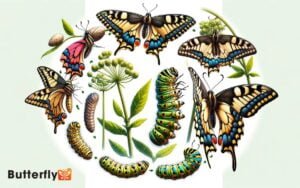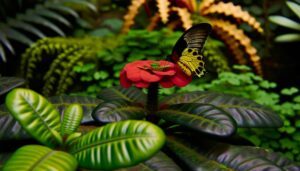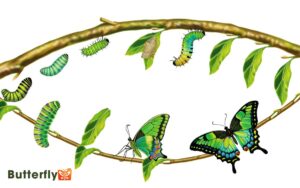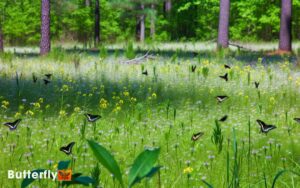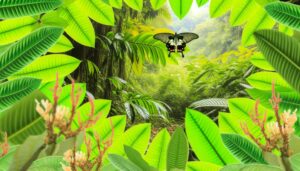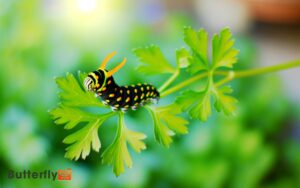Do Swallowtail Butterfly Caterpillars Eat These 7 Plants?
Swallowtail butterfly caterpillars primarily feed on plants from the Rutaceae, Apiaceae, and Lauraceae families, each providing distinct nutritional advantages. They favor citrus plants like lemon and orange in the Rutaceae family for their rich alkaloid and flavonoid content.
From the Apiaceae family, herbs such as parsley, dill, and fennel offer essential vitamins and minerals. Lauraceae plants, including sassafras and spicebush, serve as vital food sources in forested areas.
The caterpillars' feeding preferences and behaviors show evolutionary adaptations that optimize their survival and development, further revealing fascinating interactions within their ecosystems.
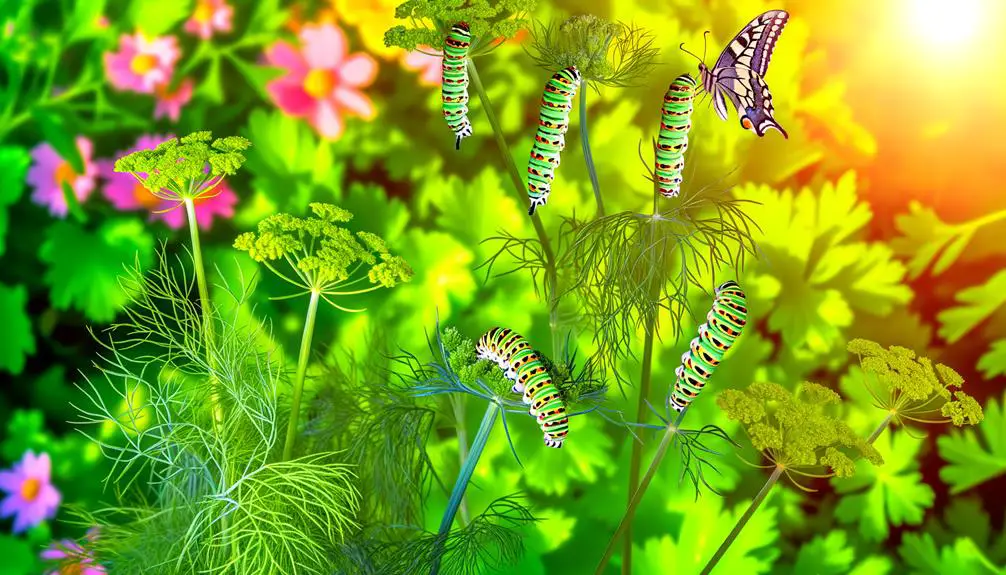
Key Takeaways
- Swallowtail caterpillars feed on plants from the Rutaceae, Apiaceae, and Lauraceae families.
- They consume citrus plants like lemon and orange, which are high in alkaloids and flavonoids.
- Parsley, dill, and carrot from the Apiaceae family are essential for their physiological processes.
- Fennel provides vital nutrients and protection, enhancing survival chances for swallowtail caterpillars.
Common Host Plants
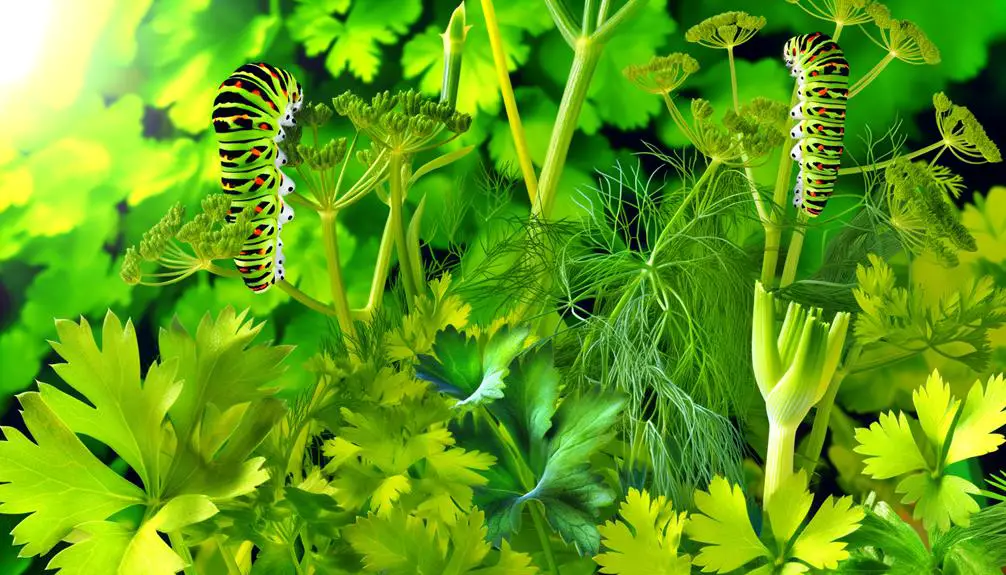
Swallowtail butterfly caterpillars primarily feed on a variety of host plants from the families Rutaceae, Apiaceae, and Lauraceae.
These botanical families provide essential nutrients that support the caterpillars' growth and development.
Rutaceae includes citrus plants such as lemon and orange trees, which are favored by certain Papilio species.
Apiaceae encompasses herbs like parsley, dill, and carrot, commonly chosen by caterpillars due to their high nutrient content.
Lauraceae consists of species such as sassafras and spicebush, which serve as critical food sources for larvae, particularly in forested areas.
Understanding these host plant preferences allows for informed conservation strategies, ensuring the preservation of both the butterfly populations and the natural habitats they depend on for their lifecycle.
Importance of Fennel
Fennel serves as a critical component in the diet of Swallowtail butterfly caterpillars due to its high nutrient content, which supports their rapid growth and development.
Additionally, fennel provides an ideal habitat that enhances the caterpillars' chances of survival.
The plant's chemical defenses also play a significant role in protecting the caterpillars from potential predators.
Nutrient-Rich Food Source
Renowned for its high nutritional value, fennel plays a critical role in the diet of swallowtail butterfly caterpillars, providing essential nutrients necessary for their growth and development.
This highly aromatic plant contains a rich array of vitamins, particularly A, C, and several B vitamins, which are fundamental for metabolic processes. Additionally, fennel offers a substantial supply of minerals such as calcium, iron, and magnesium, which support skeletal structure and enzymatic activities.
The abundance of fiber in fennel aids in digestive health, ensuring efficient nutrient absorption. Its phytochemical content, including flavonoids and essential oils, exhibits antioxidant properties that protect cellular integrity.
Consequently, fennel's extensive nutrient profile makes it indispensable for the ideal physiological and developmental needs of swallowtail caterpillars.
Habitat and Growth Support
The presence of fennel in the natural habitat of swallowtail butterfly caterpillars considerably enhances their growth and survival prospects. This plant serves as an essential host, providing both nourishment and a favorable microenvironment for larval development.
Fennel's feathery foliage offers ample surface area for caterpillars to feed, facilitating efficient nutrient intake essential for their metamorphosis. Additionally, the plant's structure and height protect caterpillars from ground-level predators and environmental extremes.
The compatibility between fennel and swallowtail caterpillars exemplifies an evolved symbiotic relationship, critical for the caterpillars' lifecycle. Habitat quality directly influences larval growth rates and overall fitness, underscoring the importance of fennel in supporting robust populations of swallowtail butterflies.
Fennel's Chemical Defense
Among its various attributes, one of the most essential aspects of fennel lies in its production of secondary metabolites that serve as chemical defenses against herbivores. These compounds not only deter generalist feeders but also attract specific Lepidoptera like Swallowtail butterfly caterpillars, which have evolved tolerance mechanisms.
| Chemical Compound | Effect on Herbivores |
|---|---|
| Anethole | Repels generalist insects |
| Fenchone | Inhibits larval growth |
| Estragole | Toxic to non-adapted pests |
The chemical arsenal of fennel guarantees its survival and propagation by reducing herbivory pressure. Consequently, Swallowtail caterpillars benefit from a niche food source with reduced competition. Their unique metabolic pathways allow them to exploit fennel's defenses, thereby guaranteeing their development and continuation.
Rue: A Key Source
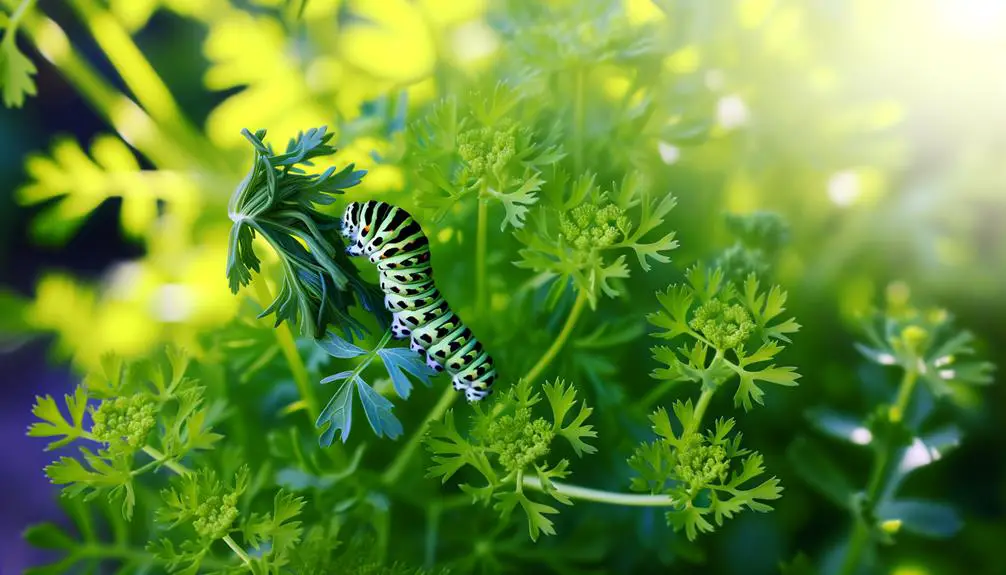
Rue (Ruta graveolens) serves as a vital food source for swallowtail butterfly caterpillars, offering essential nutrients that support their growth and development.
Observations indicate that these caterpillars exhibit a strong preference for rue, which aligns well with their feeding behavior and dietary needs.
Additionally, rue's compatibility with various habitats makes it an accessible and reliable plant for sustaining caterpillar populations.
Rue's Nutritional Benefits
As an essential component of the swallowtail butterfly caterpillar's diet, rue (Ruta graveolens) provides important nutrients that support larval growth and development.
Rich in secondary metabolites like alkaloids and flavonoids, rue plays a significant role in enhancing the caterpillar's metabolic efficiency and immune defense.
In addition, the plant's high content of essential oils and vitamins contributes to cellular differentiation and tissue formation, ensuring robust physiological function.
The presence of nitrogenous compounds in rue also aids in protein synthesis, fundamental for caterpillar development.
Moreover, the bioactive compounds in rue offer a deterrent effect against predators, thus increasing larval survival rates.
Consequently, rue's multifaceted nutritional profile underscores its relevance in the dietary ecology of swallowtail butterfly caterpillars.
Caterpillar Feeding Behavior
Swallowtail butterfly caterpillars exhibit highly specialized feeding behavior that maximizes the nutritional benefits of rue, selectively consuming parts of the plant rich in essential compounds.
These caterpillars prefer the tender young leaves and shoots, which contain higher concentrations of proteins, essential amino acids, and secondary metabolites important for their growth and development.
Their feeding strategy involves meticulous nibbling, avoiding older, tougher leaves which may possess higher levels of defensive chemicals.
This selective consumption not only fulfills their nutritional requirements but also minimizes energy expenditure and exposure to potentially harmful substances.
The precision in their feeding behavior underscores a finely tuned evolutionary adaptation, enabling these caterpillars to thrive on rue and efficiently progress through their larval stages.
Plant Compatibility
Remarkably, the dietary compatibility of Papilio species with their primary host plant, Ruta graveolens, highlights an intricate ecological relationship driven by evolutionary pressures.
Specifically, the biochemical composition of Rue, rich in furanocoumarins, acts both as a deterrent to many herbivores and as a selective attractant to swallowtail caterpillars.
This selective pressure has led to the development of specialized detoxification enzymes in Papilio larvae, enabling them to metabolize these otherwise toxic compounds.
Consequently, this adaptive mechanism guarantees the caterpillars' survival and growth, fostering a mutually exclusive relationship with Rue.
This evolutionary interplay underscores the significance of plant-host specialization in maintaining biodiversity and ecological balance, providing a riveting example of coadaptation in nature's complex web of life.
Parsley Preferences
The caterpillars of the swallowtail butterfly exhibit a marked preference for parsley, a host plant that provides essential nutrients for their growth and development.
Parsley (Petroselinum crispum) is particularly rich in vitamins and minerals, which are vital for the physiological processes of these larvae. The plant's foliage offers an ideal balance of water and fiber, facilitating efficient digestion and nutrient absorption.
In addition, the chemical composition of parsley leaves contains compounds that may deter predators, thereby offering a protective advantage.
This preference for parsley is not merely incidental but is likely an evolved trait ensuring the caterpillars' survival and successful metamorphosis. Such specificity underscores the intricate relationship between swallowtail caterpillars and their preferred host plants.
Dill Delicacies
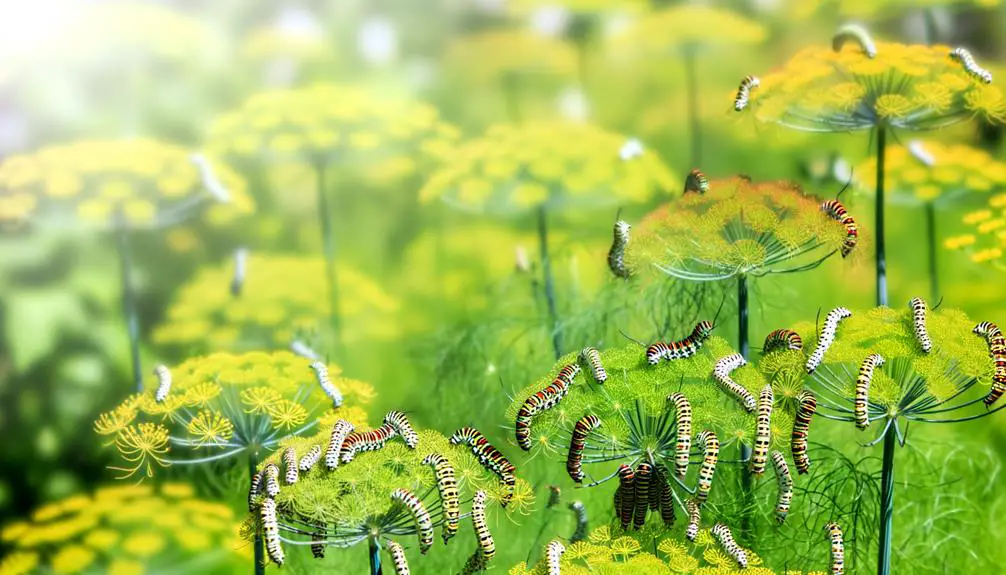
Among the various host plants, dill (Anethum graveolens) serves as another important dietary component for swallowtail butterfly caterpillars, offering a unique set of nutrients and protective compounds essential for their development.
Rich in essential oils and secondary metabolites, dill provides not only nourishment but also potential defense mechanisms against predators.
The foliage of dill is high in vitamins and minerals, contributing to the caterpillars' robust growth and metamorphosis.
Additionally, the plant contains phytochemicals such as anethole, which may play a role in deterring herbivores and pathogens, thereby ensuring a safer feeding environment.
These attributes make dill an ideal choice for swallowtail larvae, supporting their physiological needs and enhancing their survival rates in various ecological conditions.
Citrus Leaves
Feeding on citrus leaves, swallowtail butterfly caterpillars benefit from the high concentration of essential nutrients and defensive compounds that support their growth and protection. Citrus leaves are rich in various alkaloids and flavonoids, which provide both nourishment and deterrence against predators. The specific phytochemicals within citrus foliage cater to the metabolic needs of these larvae, facilitating their transformation into robust butterflies.
Nutrient Density: Citrus leaves offer an abundant source of vitamins and minerals essential for larval development.
Chemical Defense: Compounds like limonene deter potential predators.
Digestive Adaptability: Caterpillars possess enzymes that efficiently process the tough leaf tissues.
Growth Acceleration: The particular balance of nutrients accelerates the caterpillars' growth phases, ensuring timely metamorphosis.
This dietary preference exemplifies an evolutionary adaptation optimizing survival and reproduction.
Regional Variations
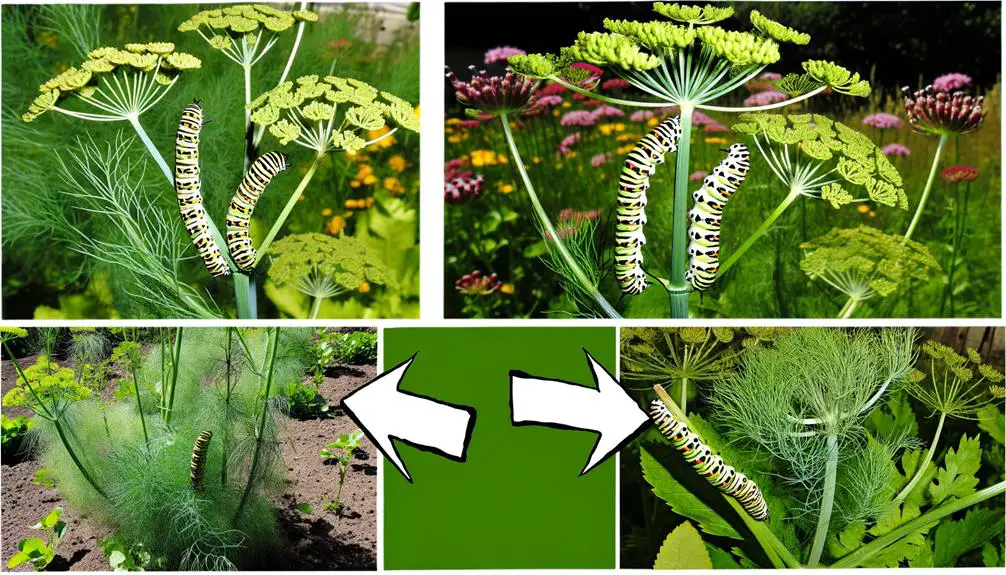
Regional variations in the diet of swallowtail butterfly caterpillars demonstrate significant adaptability to different plant species available in their respective habitats. This dietary flexibility allows them to thrive in diverse ecosystems, from temperate forests to tropical regions. The swallowtail butterfly caterpillar features specialized enzymatic adaptations that enable it to process toxins from certain host plants, providing a crucial defense against predators. This ability to utilize a wide range of plant species highlights their evolutionary success and ecological importance.
In North America, the Eastern Tiger Swallowtail (Papilio glaucus) primarily consumes leaves of the Tulip Tree (Liriodendron tulipifera) and Wild Black Cherry (Prunus serotina).
Conversely, the Old World Swallowtail (Papilio machaon) in Eurasia mainly feeds on members of the Apiaceae family, including fennel (Foeniculum vulgare) and carrot (Daucus carota).
Similarly, the Anise Swallowtail (Papilio zelicaon) in the western United States prefers plants such as anise (Pimpinella anisum) and parsley (Petroselinum crispum).
These dietary preferences reflect the caterpillars' evolutionary adaptations, enabling them to thrive in diverse ecological niches by exploiting locally abundant flora.
Conclusion
In summary, the dietary preferences of swallowtail butterfly caterpillars are varied and include a range of host plants such as fennel, rue, parsley, dill, and citrus leaves.
These plants provide essential nutrients necessary for the caterpillars' development and metamorphosis.
Regional variations also play a significant role in determining the availability of these host plants.
How might the decline of these key plants impact the survival of swallowtail butterfly populations?
Understanding these relationships is vital for conservation efforts.

